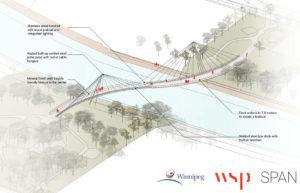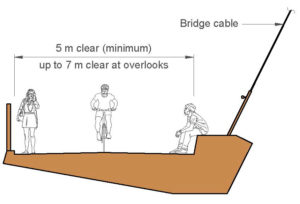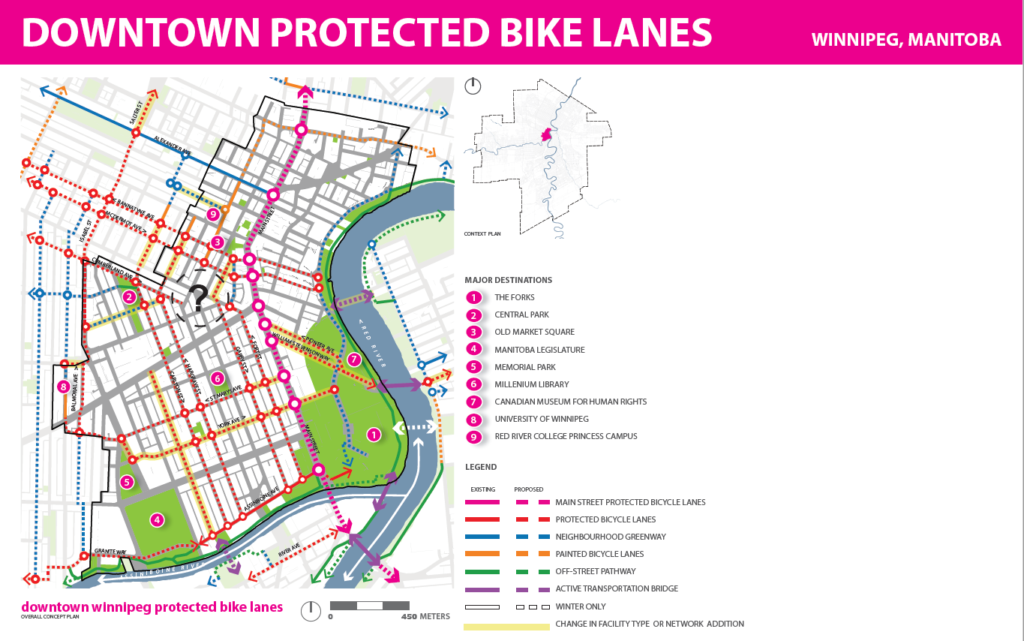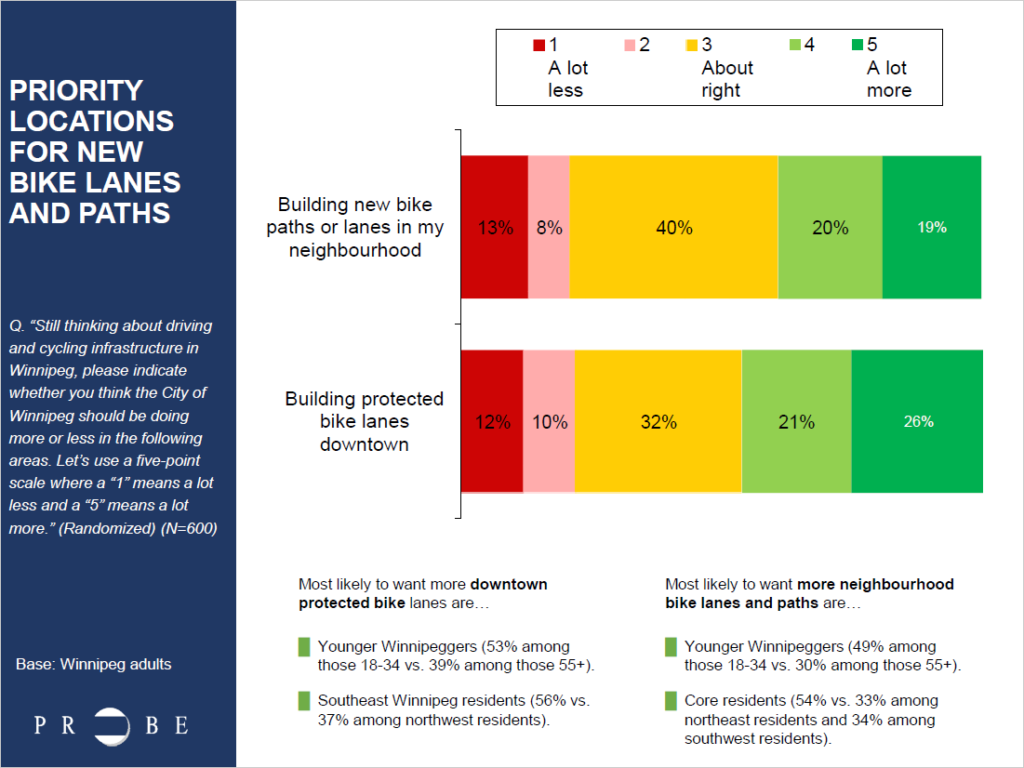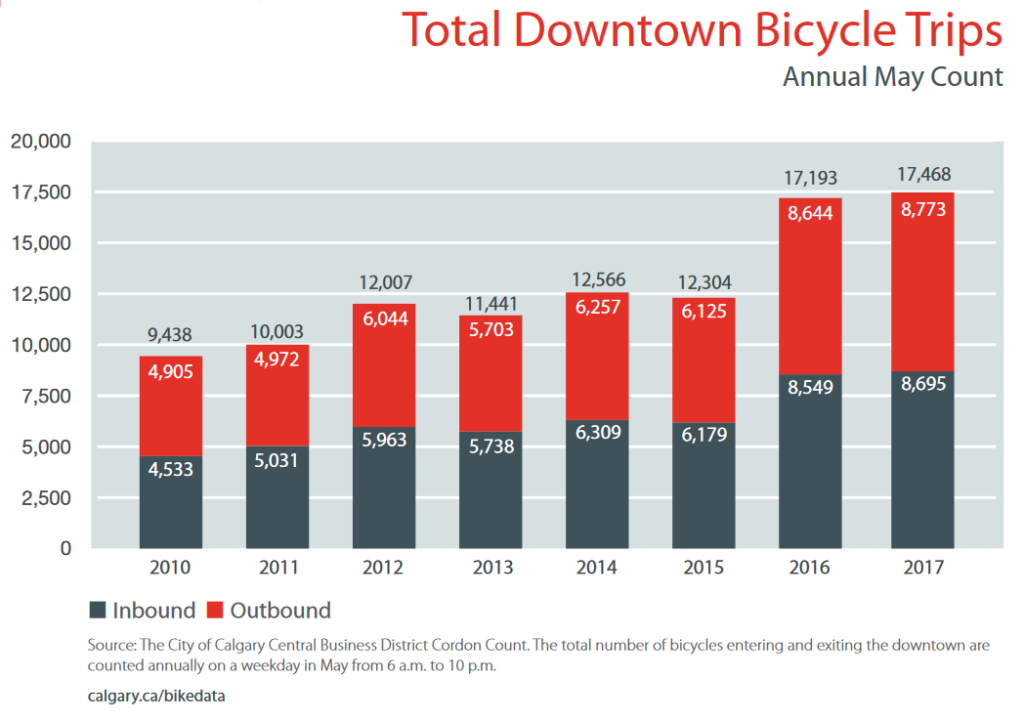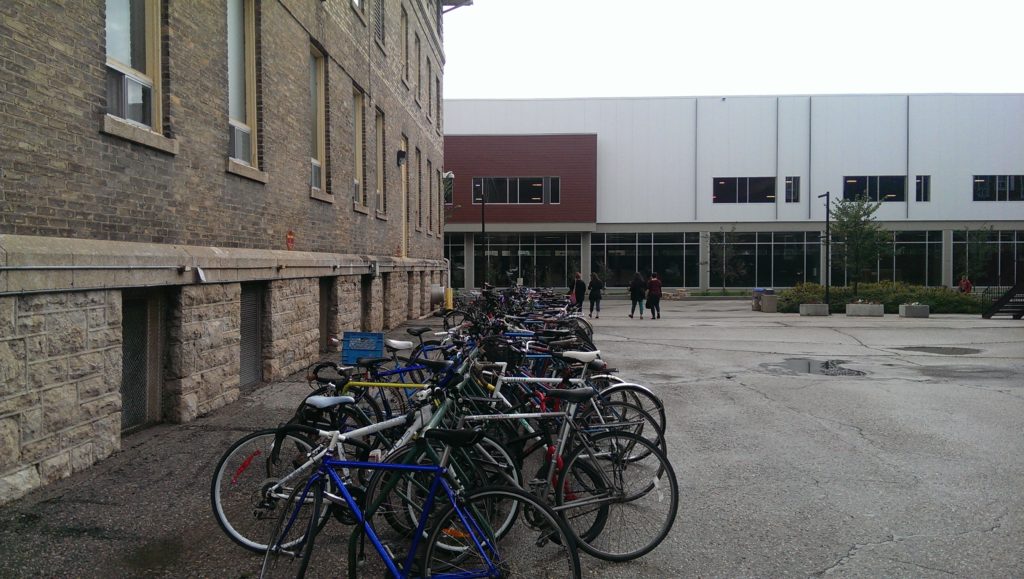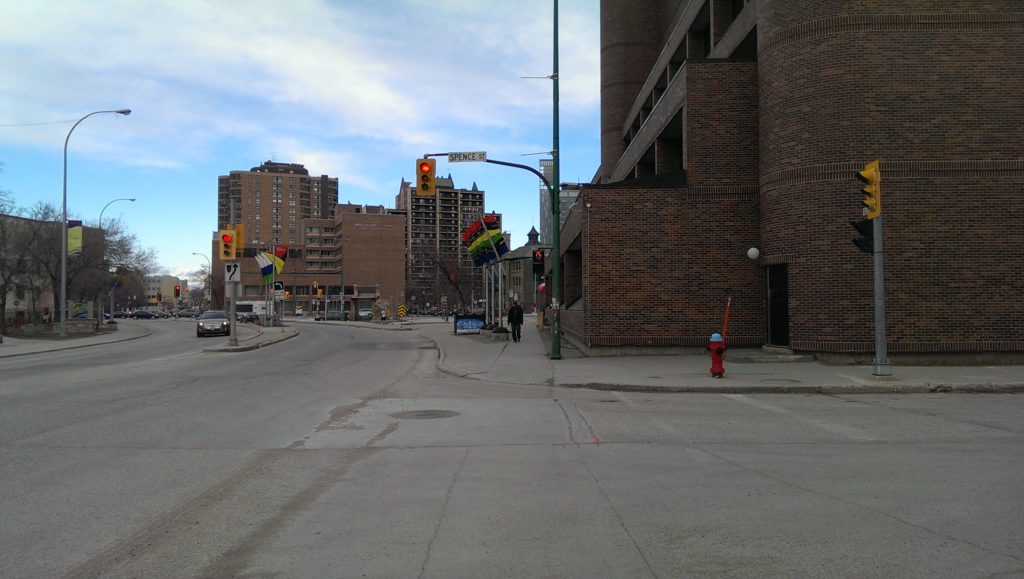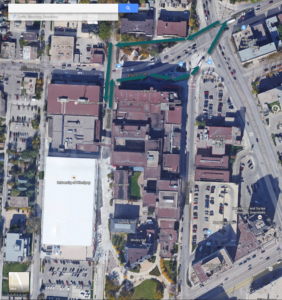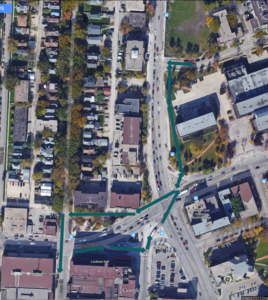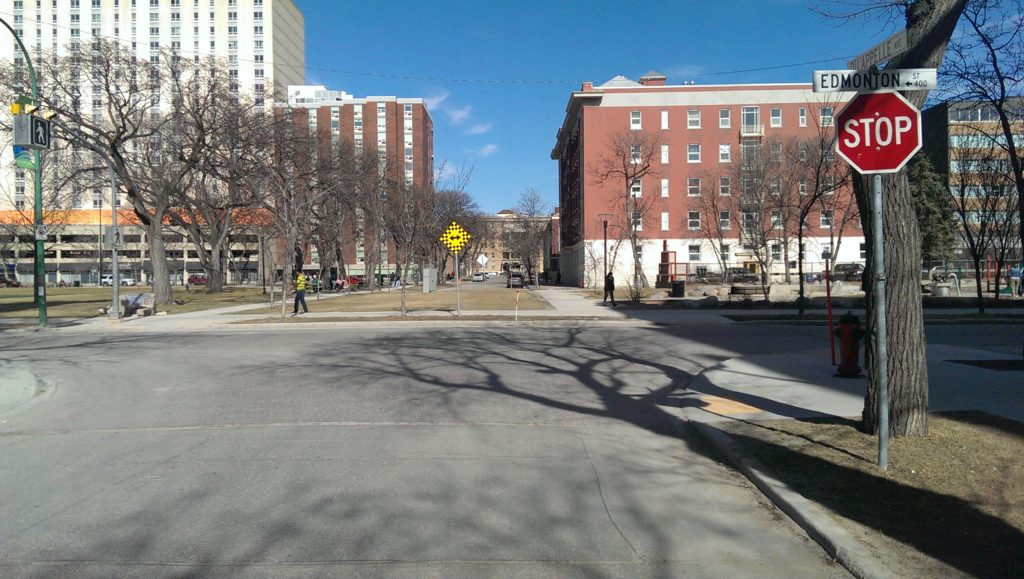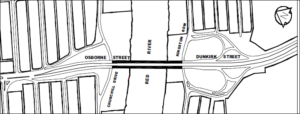
[spacer height=”1px”]
To help Council Candidates and Voters better understand cycling policy and infrastructure project priorities, Bike Winnipeg has put together a number of policy and infrastructure recommendations that we hope can be moved forward in the next term of council.
Local Priorities for Walking and Biking
Connectivity Must Not be Overlooked
Developing connections to and from the proposed Osborne Village to Downtown Walk/Bike Bridge will be just as important as development of the bridge itself. If people do not feel safe getting to the bridge, and if the routes to the proposed bridge are not direct, we can’t expect them to look at biking as a practical transportation option, and we won’t see the full usage that this bridge has the potential to generate if it is properly connected into the city’s bicycle network. Barring a complete redevelopment of the block bounded by Osborne St, Donald St., and McMillan Ave that would allow for a pathway connection across Donald St and McMillan Ave, the only viable alternative to the crossing of McMillan at Scott is to have people on bikes detour north across Osborne (at the signal near the McDonald’s south of the Osborne Underpass) via Jessie Ave, Pembina Hwy, and Nassau Ave.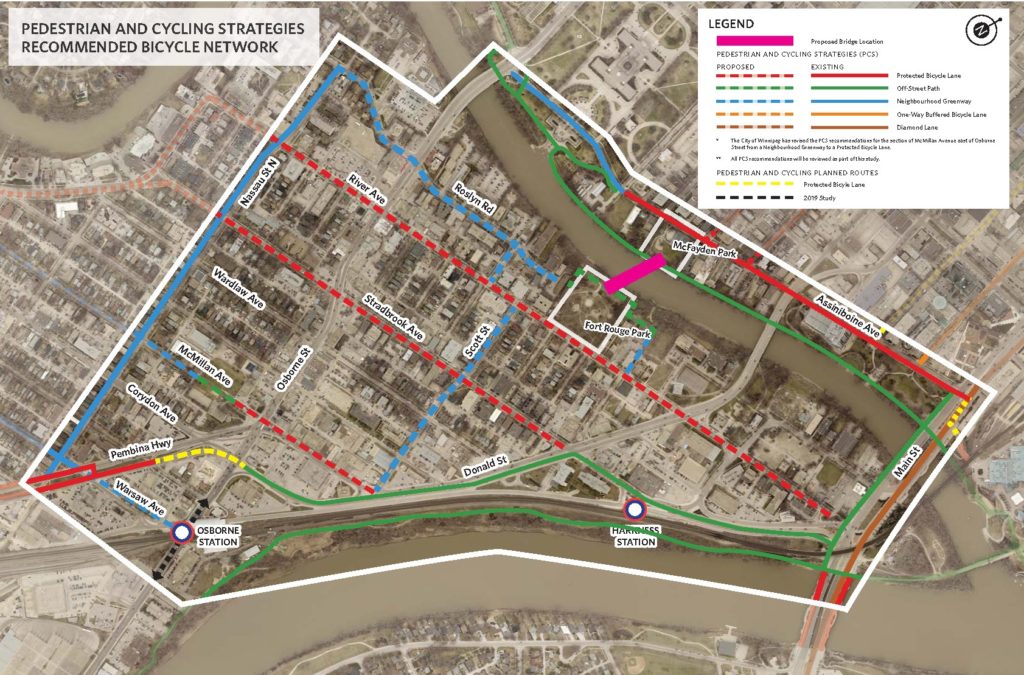
Providing connections to and from the proposed Osborne Village to Downtown Walk/Bike Bridge will be critical to the bridges success in encouraging people to give up their cars and walk or bike to their destinations. Current plans fail to provide a safe connection across Donald St at Scott Ave to the Osborne St Underpass and its future cycling improvements.
Funding for the Osborne to Downtown Walk Bike Bridge & Connections
At present, there is no funding in place to take plans for the proposed Osborne Village to Downtown Walk Bike Bridge & Connecting Bikeways beyond the preliminary design stage. Both the the Public Transit and Green Infrastructure streams of the Federal Government’s Investing in Canada Plan aim to promote active transportation, so these programs are a natural fit for funding of this project. All candidates in Fort Rouge-East Fort Garry should commit themselves to moving forward with construction of the proposed Osborne Village to Downtown Walk Bike Bridge & Connecting Bikeways and to including funding for this project as a top priority in the next round of Federal Government funding through the Invest in Canada Plan.Rehabilitation Plans for the Osborne St Underpass Depend on Connections through Confusion Corner.
Preliminary design for a major rehabilitation of the Osborne Street Underpass, with provisions to widen the underpass to accommodate pedestrian/cycling pathways is currently scheduled for 2019. However, the City of Winnipeg’s 2018 Capital Budget notes that rehabilitation of the Osborne St Underpass will not proceed to detailed design until the pedestrian and cycling network north past Confusion Corner and South to the St. Vital Bridge has been determined and becomes a priority to construct. More Information- Osborne Village to Downtown Walk/Bike Bridge & Connections (City of Winnipeg)
- Osborne Underpass Rehabilitation Capital Project (City of Winnipeg)
- St. Vital Bridge Rehabilitation Capital Project (City of Winnipeg)
Downtown Separated Bicycle Lane Network
Despite having been identified as a short-term “quick win” that should be prioritized in the next one or two years.[1], construction of the city’s down town separated bike lane network is finally starting to take shape with the completion of the McDermot/Bannatyne Avenue protected bike lanes in 2018 (plus segments of the Princess, Notre Dame, Hargrave, and Carlton Protected Bike Lanes) and the expected completion of the Garry Street protected bike lanes in 2019.
Still, full build-out of the downtown separated bicycle lane network is not within the 3-year planning horizon of the 2018 Pedestrian and Cycling Program Action Plan, and even then the planned network will not provide the level of connectivity recommended in the Downtown by the Pedestrian and Cycling Strategies (400m grid width).[2]
A June 2018 Probe Research poll found substantial support for installation of protected bike lanes in the downtown. When asked if they think the City of Winnipeg should be building more or less protected bike lanes in the downtown, almost half (47 per cent) of respondents said the city should be building more protected bike lanes downtown.
We urge the city to fast track development of the downtown separated bicycle lane network by committing to plan for all remaining segments (and proposed additions along St. Mary & York) in 2019, and by installing adjustable separated bike lanes in 2019/2020 to be followed with permanent installations as the roadways undergo planned renewals.
Case Study
In 2015, the City of Calgary fast tracked the planning and installation of a five street downtown protected bike lane network using cheaply installed adjustable barriers (similar to those being piloted in Winnipeg right now).
Results:
- Ridership has tripled along the network.
- Bicycle trips into and out of downtown increased by 40% between the 2015 and 2016.
- Perception of safety of people cycling increased from 68% to 91%.
- People are going one or two blocks out of their way to use the cycle tracks.
- The highest ridership occurs where cycle track routes are closer together.
Footnotes
[1] Page 312, Pedestrian and Cycling Strategies, City of Winnipeg, 2015
[2] Page 135, Pedestrian and Cycling Strategies, City of Winnipeg, 2015
With over 10,000 students, staff, and faculty, the University of Winnipeg’s Downtown Campus is one of the Downtown’s most important destinations. If we want to get more people biking more often, we will have to ensure that the U of W’s Downtown Campus is served by multiple low stress bikeways that are direct, convenient, and comfortable. With the high volume of trips coming into the U of W, it is also important that the bikeways we develop to provide access to the University are built to manage a high number of cyclists.
Improvements to the Maryland/Sherbrook bikeways and the recent upgrade of painted bike lane to protected bike lanes on McDermot and Bannatyne Avenues, combined with planned upgrades from painted to protected bike lanes on Hargrave St (Study & Functional Design in 2020), Ellen/Carlton St (Study & Functional Design in 2020), Garry St (construction in 2019), and Princess St (Functional Design 2018) will provide a vast improvement to bikeway connections to the U of W Campus, but the final few blocks between these bikeways and the U of W have little to no facilities for people on bikes. Certainly nothing that would qualify as an all ages and abilities bike route.
St. Mary Ave Protected Bike Lanes
St. Mary Avenue is proposed as part of the Downtown Protected Bike Lane Network in the Pedestrian & Cycling Strategies (PCS), and would provide an excellent connection to the U of W if this plan was followed through on as it provides an almost direct connection from the Downtown protected bike lanes to Spence Street, which acts as pedestrian mall through the heart of the U of W Campus.
St. Mary between Ave is scheduled for a major rehabilitation between Portage Ave and Memorial Blvd in 2022. Including installation of protected bike lanes along St. Mary during the scheduled rehabilitation work will require design work to begin in either 2020 or 2021.
The challenge will be connecting St. Mary Ave across Portage Ave to Spence St. Options to provide space for protected bike lanes might include the elimination of right turns off of St. Mary onto Portage (they can be directed to Balmoral easily enough).
If a way could be found to provide a connection between the Spence St Pedestrian Mall and Qu’Appelle Ave, between St. Mathews Ave and Spence St,and between Spence St and St. Mary Ave, a whole series of connections between key spines in the city’s planned bicycle network could be realized.
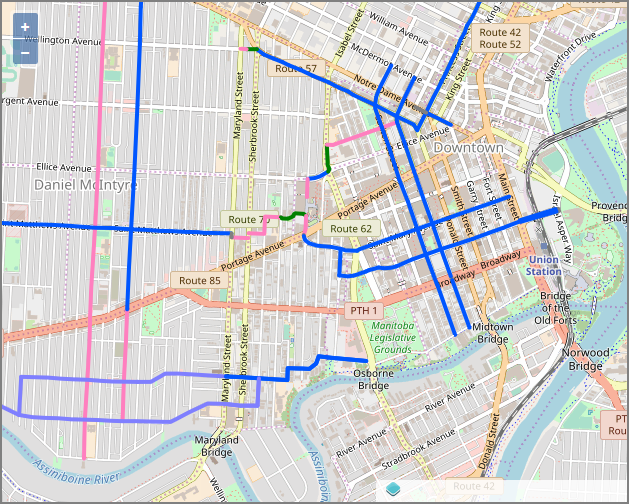
By providing connections to the U of W’s Spence St Pedestrian Mall from St. Mathews, Qu’Appelle, and St. Mary, multiple gaps in the city’s cycling network can be removed.
A substantial benefit to providing connections to the U of W through the Spence St Pedestrian Mall is that such connections would provide direct access to the University’s main bicycle parking area and the UWSA BikeLab.
St. Matthews Ave – U of W Connection
In the Pedestrian and Cycling Strategies (PCS) adopted in 2015, St. Matthews Ave is identified as one of the network spines of the proposed bike network, providing an all ages and abilities cycling route on pathways and protected bike lanes from the Sturgeon Creek Pathway all the way to Maryland St. From there, the intent of the PCS is to provide a mix of pathways and on road routes along low volume residential streets to complete the connection to the U of W Campus.
It’s likely that this connection will require a couple of property acquisitions as well as signalized crossings of Maryland St and Sherbrook St.
Spence-Qu’Appelle Bikeway
The northern connection to the U of W in the Pedestrian and Cycling Strategies (PCS) is through Qu’Appelle Ave and Balmoral St. One drawback to Balmoral St as a connection through the U of W is that if does not provide access to the planned St. Matthews cycling spine. A second drawback is that there seems to be little political will to remove travel lanes on Balmoral St to provide the planned protected bike lanes.
The suggested route that follows avoids any on-road bikeways along Balmoral St and provides the needed connection between Spence St and Qu’Appelle Ave, with a recommendation to treat Qu’Appelle Ave as a Neighbourhood Greenway instead of a protected bike lane. Traffic volumes on Qu’Appelle are low enough that a neighbourhood greenway treatment that allows for mixing of motorized traffic with people on bikes would meet the needs of an all ages and abilities cycling route.
Ellice Segment- Spence to Balmoral
East bound bicycle traffic would be accommodated between Spence St and Balmoral St by combining the following infrastructure:
- Adding a raised bicycle lane on the south side of Ellice between Spence and the driveway in front of the University (there is space available).
- Providing cyclists with a connection from the driveway in front of the U of W to the northbound bus lane leading out of the Balmoral Transit Station.
- Adding bike lanes and a bike box to the north end of the bus lane.
- Reprogramming of the traffic signal to ensure that there is a protected phase for cyclists connecting diagonally across the intersection.
- A redesign of the traffic island and merge lane on the northeast corner of the Ellice/Balmoral intersection that would:
- Reduce the speed of vehicles turning off Ellice onto Balmoral
- Add a two way bike path across the traffic island.
- Provide a raised crossing for pedestrians and cyclists coming off of the traffic island
- Add stop control to protected cyclists and pedestrians crossing the merge lane.
West bound cyclists could be accommodated by combining the following infrastructure:
- A bike box and bike signal using a leading bicycle interval that would permit a cyclist to cross Balmoral and reach the laneway on the north side of Ellice prior to westbound motorized traffic. Alternatively, cyclists may choose to take the left lane on Ellice and make a vehicular turn onto Spence. The bike box accommodates both options. There is already space against the traffic island for the bike lane leading into the bike box (short bike lanes such as this are often referred to as pocket bike lanes).
Balmoral Segment – Ellice to Qu’Appelle
Once across the Ellice/Balmoral intersection, cyclists could be accommodated by building a two way bike path on the east side of Balmoral between Ellice and Qu’Appelle. There is adequate space available for such a pathway. The cycling strategy calls for protected bike lanes on Balmoral. If this path is followed, there would be no need for this pathway as cyclists would make used of the protected bike lanes on Balmoral.
East of Balmoral
East of Balmoral, Qu’Appelle would function as a neighbourhood greenway with mixed traffic. A pathway could be built through Central Park to connect between Edmonton and Carlton, which have existing painted bike lanes that are scheduled to be converted into protected bike lanes as a short term goal of the cycling strategy. There would be a need to improve the intersection treatments at Kennedy, Edmonton, Carlton and Hargrave utilizing curb bump-outs and traffic signals where traffic demands. These changes would benefit pedestrian and bicycle users.
More Information
Downtown Bike Lane System and Street Improvements (City of Winnipeg)
The Churchill Pathway follows the west side of the Red River from The Forks to Togo Avenue neat the Osborne St Transit Garage where it currently ends. The Churchill Pathway – Churchill Dr to Togo Extension would aim to extend the pathway south to Brandon Ave at Hay St, where a neighbourhood greenway built in 2010 provides a connection south to the St. Vital Bridge on Osborne St.
Property acquisition for the project is scheduled for 2019 in the 2018 Pedestrian and Cycling Program Action Plan, with construction set to follow in 2020. Estimated costs for property acquisition and construction are expected to be $2.65 million. This is an important addition to the city’s bicycle network, and we want to ensure that it continues to move forward.
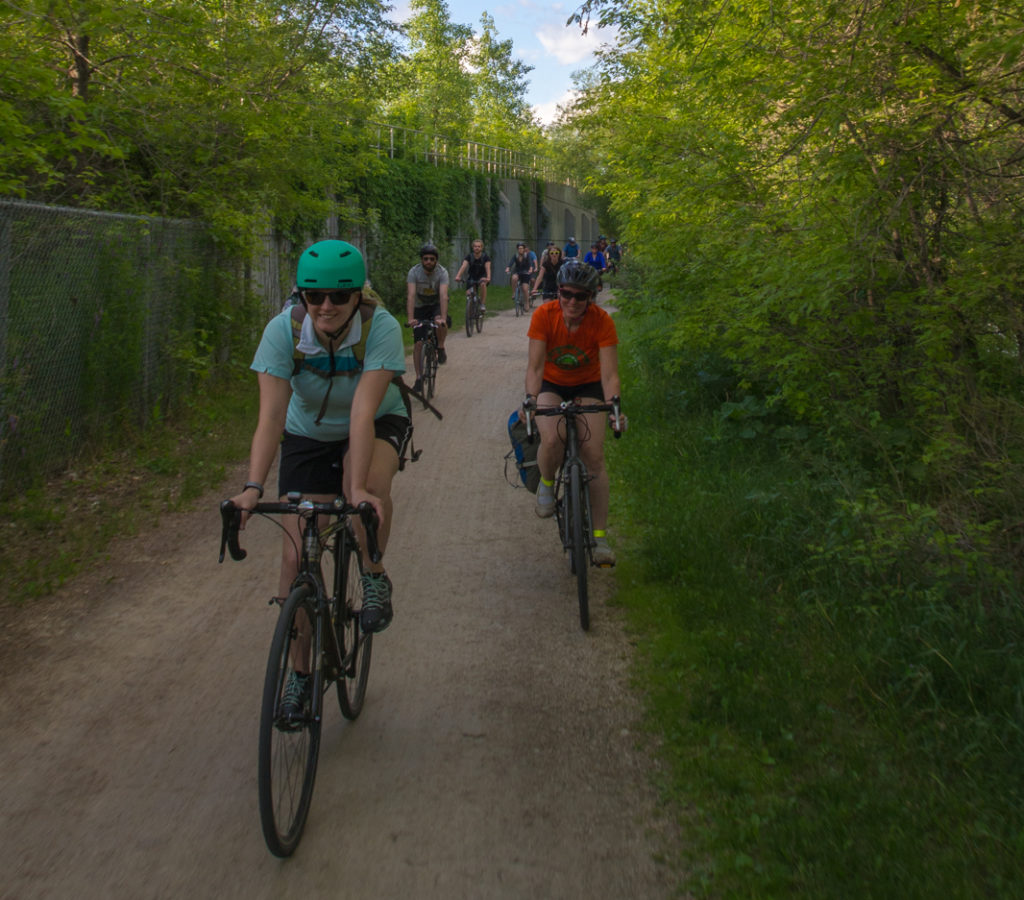
Extension of the Churchill Pathway south to Brandon Ave at Hay St would provide much needed connectivity into Riverview and fill a gap in the bicycle network between the St. Vital Bridge and the Osborne St Underpass.
Completion of the Churchill Pathway to Brandon Ave/Churchill Dr at Hay St would provide an important connection into Riverview from the Forks and from the Osborne St Underpass (which in turn will eventually connect to the Southwest Rapid Transit Corridor pathways and the proposed Osborne Village to Downtown Walk/Bike Bridge), and will fill a gap in the bicycle network between the St. Vital Bridge and the Osborne Street Underpass. Connections west to the Fort Rouge Yards pathway and Southwest Rapid Transit Corridor Pathway would also be facilitated by completion of this section of pathway.
Rehabilitation Plans for the Osborne St Underpass Depend on Connections through Confusion Corner.
Preliminary design for a major rehabilitation of the Osborne Street Underpass, with provisions to widen the underpass to accommodate pedestrian/cycling pathways is currently scheduled for 2019. However, the City of Winnipeg’s 2018 Capital Budget notes that rehabilitation of the Osborne St Underpass will not proceed to detailed design until the pedestrian and cycling network north past Confusion Corner and South to the St. Vital Bridge has been determined and becomes a priority to construct (see page 2-26 in the 2018 Capital Budget).
Preliminary design for rehabilitation work on the St. Vital Bridge, which would include improvements in accommodations for people on foot or bike, is currently scheduled for 2022.
More Information
- Osborne Underpass Rehabilitation Capital Project (City of Winnipeg)
- St. Vital Bridge Rehabilitation Capital Project (City of Winnipeg)
- 2018 Pedestrian and Cycling Program Action Plan (City of Winnipeg)
- Osborne to Downtown Walk/Bike Bridge & Connections Study (City of Winnipeg)
- Osborne Village to Downtown Walk/Bike Bridge & Connections Backgrounder (Bike Winnipeg)
The Osborne Street Underpass has to be one of the biggest barriers to cycling in the City of Winnipeg. People on bikes are squeezed up against a giant wall of concrete and forced to share a narrow, pot-holed roadway with a an endless stream of buses, trucks, and cars.
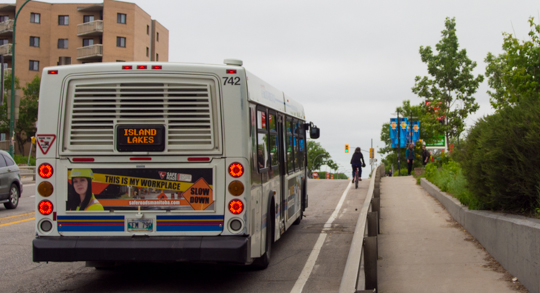
Improving conditions for cyclists and pedestrians through the Osborne Street Underpass should be a higher priority than building freeways into undeveloped lands
The good news is that preliminary design work for a major rehabilitation of the Osborne Street Underpass is scheduled for 2019, and will study provisions to widen the underpass so that it can accommodate pedestrian/cycling pathways.
However,there is currently no funding in place to carry on rehabilitation work, and the City’s 2018 Capital Budget notes that rehabilitation of the Osborne St Underpass will not proceed to detailed design until the pedestrian and cycling network north past Confusion Corner and South to the St. Vital Bridge has been determined and becomes a priority to construct.
Two projects are underway or scheduled to begin in the near future to address gaps in the bicycle network and provide a connection from the St. Vital Bridge north past Confusion Corner. The Churchill Pathway – Churchill Dr to Togo project is scheduled for development over 2019 and 2020, and will fill in the gap between Brandon Ave and Togo Ave on the bike route between The Forks and the St. Vital Bridge along the Churchill Pathway and the Hay St Neighbourhood Greenway.
Osborne Village to Downtown Walk/Bike Bridge Study Failing to Provide Connection North of Confusion Corner
The second project tasked with determining how the biking network will provide people on bikes with a safe connection north of Confusion Corner from the St. Vital Bridge is the Osborne to Downtown Walk/Bike Bridge and Connections study.

Providing connections to and from the proposed Osborne Village to Downtown Walk/Bike Bridge will be critical to the bridges success in encouraging people to give up their cars and walk or bike to their destinations. Current plans fail to provide a safe connection across Donald St at Scott Ave to the Osborne St Underpass and its future cycling improvements.
Absent to date from plans presented in the Osborne to Downtown Walk/Bike Bridge and Connections Study are a desperately needed connection from the Osborne St Underpass to the east/west bike routes north of Confusion Corner that have been offered up as potential connections to the proposed bridge.
In particular, the study has looked into, but abandoned any plans for a signalized or grade separated crossing of McMillan/Donald at Scott Street to provide a direct route between the Osborne Underpass and the Osborne to Downtown Walk/Bike Bridge.
Summary of Recommendations
We are asking for three commitments from candidates with respect to the Osborne St Underpass:
- Commit to widen the underpass as part of upcoming rehabilitation work so that it can accommodate pedestrian/cycling pathways.
- Commit to demanding that any plans for the Osborne to Downtown Walk/Bike Bridge include a safe crossing of Donald Street to provide a direct, convenient, and comfortable connection from the Osborne St Underpass pathways to the Osborne to Downtown Walk/Bike Bridge.
- Commit to making rehabilitation and widening of the Osborne St Underpass to accommodate pedestrian/cycling pathways a funding priority for the city.
More Information
- Osborne Underpass Rehabilitation Capital Project (City of Winnipeg)
- St. Vital Bridge Rehabilitation Capital Project (City of Winnipeg)
- Osborne Village to Downtown Walk/Bike Bridge & Connections (City of Winnipeg)
- Churchill Pathway – Churchill Dr to Togo Backgrounder (Bike Winnipeg)
- 2018 Pedestrian and Cycling Program Action Plan (City of Winnipeg)
Connecting the Churchill Pathway, the Hay St Neighbourhood Greenway, Kingston Row, the Dunkirk Pathway, and the Niakwa Pathway, the St. Vital Bridge over the Red River and the tunnels at its north and south ends are scheduled for a major rehabilitation in 2024 and 2025. Preliminary design for the rehabilitation work is scheduled for 2022, with detailed design scheduled for 2023.
Included in the work will be marginal bridge widening to better accommodate pedestrian and cycling requirements.
At present,the only accommodation for people traveling across the bridge on bikes are 1m shy-lanes between the travel lanes and the barriers for the sidewalks. Not surprisingly, many people biking across the bridge choose to ride over the Red River in the sidewalks, not the shy-lanes. Connections from the southern tunnel to Kingston Row and across the on/off ramps for KIngston Row are also absent, as are connections to the northern tunnel from Montgomery Ave.
Within the Pedestrian and Cycling Strategies, a potential site for a new walk/bike bridge over the Red River has been identified between vacant parklands just west of the Winnipeg Canoe Club and the the grounds of the Wildwood Park Community Centre on the west side of the Red River. While not a high priority for construction at this point, a walk/bike bridge at this location would connect the Niakwa and Dunkirk Pathways to the Oakenwald/McGillivray Pathways.
Summary of Recommendations
We recommend that design studies and subsequent rehabilitation work on the St. Vital Bridge include the following:
- Improved Accommodation of Walking and Cycling on the bridge, including shared use pathways on both the east and west sides of the bridge with transitions between the roadway and pathways at the north and south ends of the bridge;
- Extension of the Dunkirk/Niakwa Pathway across the Kingston Row on/off ramps at the southern end of the bridge;
- A Paved Pathway Connection of between Cunnington Ave and the Dunkirk/Niakwa Pathway at the southern end of the bridge;
- A Paved Pathway Connection from Dunkirk Pl to the west side of the southern walk/bike tunnel to provide a connection between the Dunkirk/Niakwa Pathways and the Elm Park Walk/Bike Bridge that avoids the Kingston Row Underpass;
- A Pathway Connection from the Northern end of the bridge to Montgomery Avenue;
- Improved Lighting in both the north and south walk/bike tunnels;
- Improve sight lines through both the north and south walk/bike tunnels;
- Any property easements needed for a future walk/bike bridge between the vacant park located located west of the Winnipeg Canoe Club and the Wildwood Park Community Centre grounds on the west side of the Red River.
More Information
- St. Vital Bridge Rehabilitation Capital Project (City of Winnipeg)
Since 2008, the City of Winnipeg has been installing buffered bike lanes along Pembina Highway as part of routine rehabilitation work on the roadway funded through the Regional Street Renewals Program. To date, sections of buffered bike lane have been installed (or are being installed) along the following stretches of Pembina Hwy:
- Jessie Ave to Grant Ave (scheduled for completion in 2019)
- Harrow St to Point Road (as part of the Pembina Underpass Rehabilitation project)
- Chevrier Ave/Crescent Dr to Plaza Dr
- University Cr to Markham Rd
- Chancellor Matheson Rd to Dalhousie Dr/Bairdmore Blvd
- Bairdmore Blvd/Dalhousie Dr to De Vos Rd
- De Vos Rd to Cloutier Dr (shared use path beneath the South Perimeter Highway Overpass)
- Cloutier Dr to South of Ducharme Ave
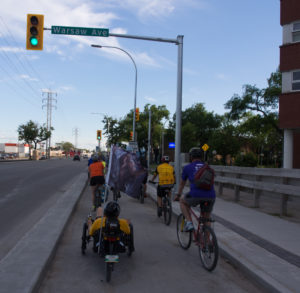
The city has been installing buffered bike lanes on Pembina Hwy since 2008 as part of routine roadway rehabilitation work.
The addition of buffered (or preferably protected) bike lanes on Pembina Hwy is backed key recommendations in the Complete Communities Policy Document[1] and Pedestrian and Cycling Strategies[2].
Current forecasts of rehabilitation work in the Regional Streets Renewal Program and Accelerated Regional Streets Renewal Program call for rehabilitation work on the following stretches of Pembina Hwy:
- Des Trappistes to Ducharme Ave (2021)
- McGillivray Ave to Chevrier Ave (2022)
- Pembina Hwy Overpass (2022 & 2023)
That will leave gaps in the buffered/protected bike lanes along the following stretches of Pembina Hwy:
- Grant Ave to Harrow St
- Point Rd to McGillivray Ave
- Plaza Dr to University Cr (should be included in Pembina Hwy Overpass rehabilitation)
- Markham Rd to Chancellor Matheson Rd
- Des Trappistes to Turnbull Dr
Complete Installation of Buffered/Protected Bike Lanes Along Pembina Hwy
We are asking candidates in the Fort Rouge-East Fort Garry, River Heights-Fort Garry, Waverley West, and St. Norbert-Seine River wards to commit to:
- Continue installing buffered/protected bike lanes along Pembina Hwy as part of the Regional Streets Renewal Programs;
- Commit to the inclusion walking and cycling improvements as part of the forthcoming Pembina Hwy Overpass (Bishop Grandin) Rehabilitation Project.
- Preliminary Design Currently Scheduled for 2020
- Detailed Design Currently Scheduled for 2021
- Construction Currently Scheduled for 2022 & 2023.
- Commit to Closing the Remaining Gaps in the Buffered/Protected Bike Lanes Along Pembina Hwy.
Footnotes
[1] City of Winnipeg, Complete Communities Policy Direction Document. 2011. Winnipeg – Regional Mixed Use Centres – Direction 1 (pg. 46) “Create strong, multi-modal and transportation linkages from each Regional Mixed Use Centre to Downtown, other Centres, Corridors, Parks and major attractions.”
[2] City of Winnipeg, Pedestrian and Cycling Strategies. 2015. Pg. 154-155, Winnipeg
Ward Boundaries: Legal Description Map
